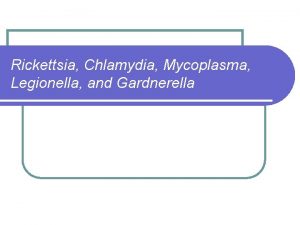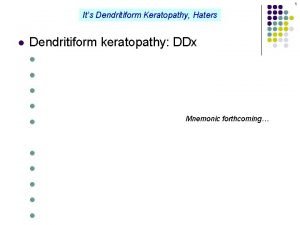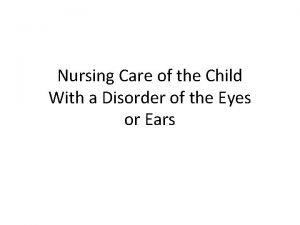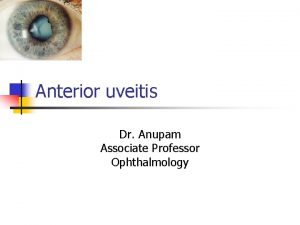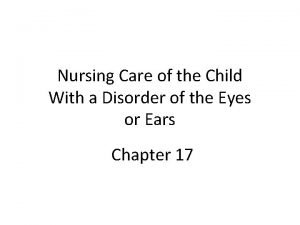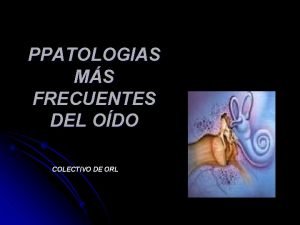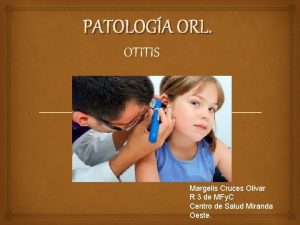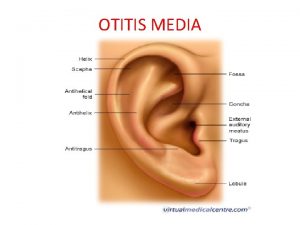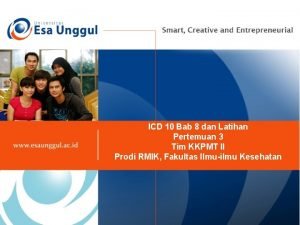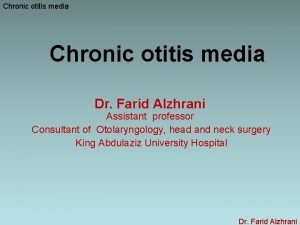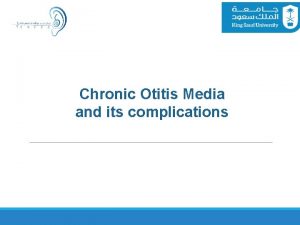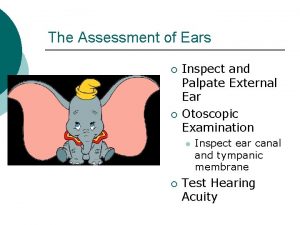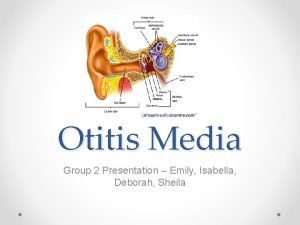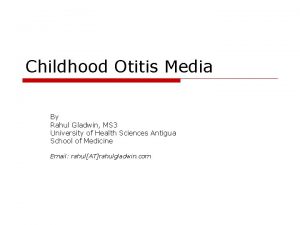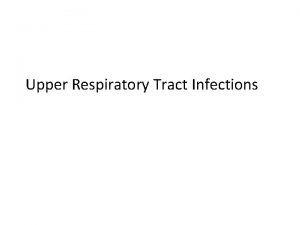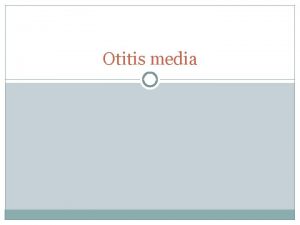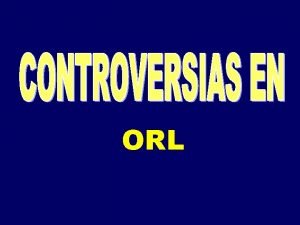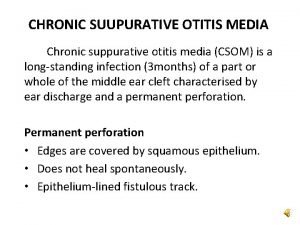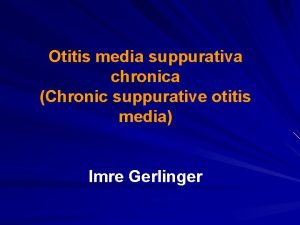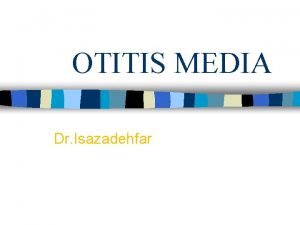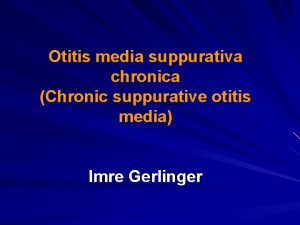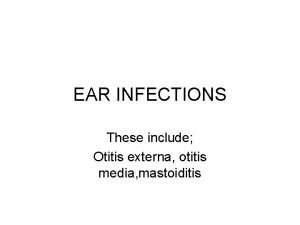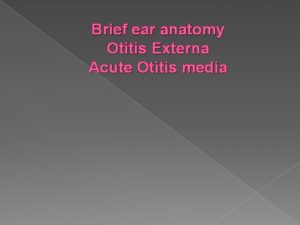Infection Otitis Media and Conjunctivitis Otitis Media Perry




















- Slides: 20

Infection: Otitis Media and Conjunctivitis

Otitis Media Perry, pp. 13141317

Etiology Most common in childhood—usually in first 24 mos n Infection of middle ear behind eardrum with inflammation of canal and eardrum from strep, haemophilus, or moraxella. n Types in Box 46 -5 n Usually preceded by RSV or flu n

Pathophysiology Infection travels thru nose or throat and goes up eustachian tube n Blocked eustachian tubes from edema or enlarged adenoids fail to drain middle ear n Tubes can become contaminated from reflux, aspiration, sneezing, blowing nose n

Manifestations Purulent matter and fluid collection causes bulging and pain; popping sensation, pressure. Sudden relief of pain may indicate perforation n See Box 46 -6 n OME may have no overt sx n

Otoscopic Exam Otoscopic exam reveals loss of light reflex and bony landmarks; bulging, red, immobile eardrum; bubbles behind eardrum with serous (OME) n Tympanogram is flat n

Risk Factors Small, short airways and eustacian tubes n Family hx n Second-hand smoke—causes pathogens to attach to middle ear n Day care or other crowded settings n Hx allergies, cleft palate, Down n Bottle feeding in supine position n

Antibiotic Treatment n n n All children < 6 months old because of immature immunity All children 6 mos to 2 y. o. if fever and severe pain are present. Amoxicillin 80 -90 mg/kg/d bid x 5 -7 d If allergic—azithromycin, cephalosporins IM Rocephin for resistance or noncompliance (use with lidocaine)

“Watchful Waiting” In children ages 6 -24 mos, if fever and pain are not present, then observation is OK x 72 h n No antibiotics are needed if improved n Obs for 2 -12 y. o. x 72 h; no antibiotics if improved n

Supportive Care Analgesic/antipyretic n Benzocaine or herbal ear drops (Allium sativum, Verbascum thapsus, Calendula flores, Hypericum perforatum, lavender, and vitamin E) n Topical pain relief n

Complications Repeated & resistant cases and persistent perfusion and hearing loss may require myringotomy with placement of tympanostomy tubes and possible adenoidectomy n Meningitis n Mastoiditis n Hearing loss n

Nursing Responsibilities n n n Pain relief Manage ear drainage Encourage parent to give child all of medication Encourage immunizations esp. PCV and Hib Follow orders and educate regarding management of tubes Refer children who have hearing loss

Parent Education n n n Causes of infection S/S of infection Prevention—breastfeeding, no smoking, no bottle propping, feeding in semireclining position Recognition and prevention of complications Med administration Avoid air travel

Conjunctivitis p. 1194

Etiology & Pathophysiology Most common eye disease n Inflammation of the conjunctiva n Viral, bacterial, allergic, foreign body n Bacterial called “pink eye” and caused by Staph or Haemophilus n

Manifestations Redness n Edema n Pain, scratchy or itchy feeling n Mild photophobia n Watery or purulent drainage n

Diagnostics C & S for bacterial or viral n Conjunctival scrapings can also detect microorganisms n Fluorescein dye to detect FBs and trauma n

Treatment Eye drops for newborns to prevent Chlamydia and gonorrhea n Topical anti-infectives applied as eye drops or ointments usually erythromycin, gentamicin, or penicillin, acyclovir n Severe cases require systemic tx n Antihistamines for allergic n

Supportive Care Warm or cool compresses n Cleaning away drainage n Eye irrigations n Analgesics n Avoid bright lights, reading n Sunglasses n No contact lenses n

Parent Education Prevent spread of bacterial—wash hands, don’t share stuff, don’t return to school until 24 h of med n Wash hands before eye drops n Don’t contaminate eye dropper n Reduce lighting n No reading n
 Catarahh
Catarahh Icd 9 code for seasonal allergies
Icd 9 code for seasonal allergies Follicular conjunctivitis
Follicular conjunctivitis Follicular conjunctivitis
Follicular conjunctivitis Conjunctivitis nursing management
Conjunctivitis nursing management Conjunctivitis
Conjunctivitis Uveitis definition
Uveitis definition Fliktena
Fliktena Autism nursing diagnosis
Autism nursing diagnosis Clasificación de la otitis media
Clasificación de la otitis media Clasificación de la otitis media
Clasificación de la otitis media Pruebas acumetricas
Pruebas acumetricas Adhesive otitis media
Adhesive otitis media Tinnitus icd 10
Tinnitus icd 10 Acute suppurative otitis media
Acute suppurative otitis media Myringplasty
Myringplasty Weber rinne
Weber rinne Tympanosclerosis
Tympanosclerosis Fluid behind eardrum
Fluid behind eardrum Wikimedia
Wikimedia Serous otitis media
Serous otitis media


